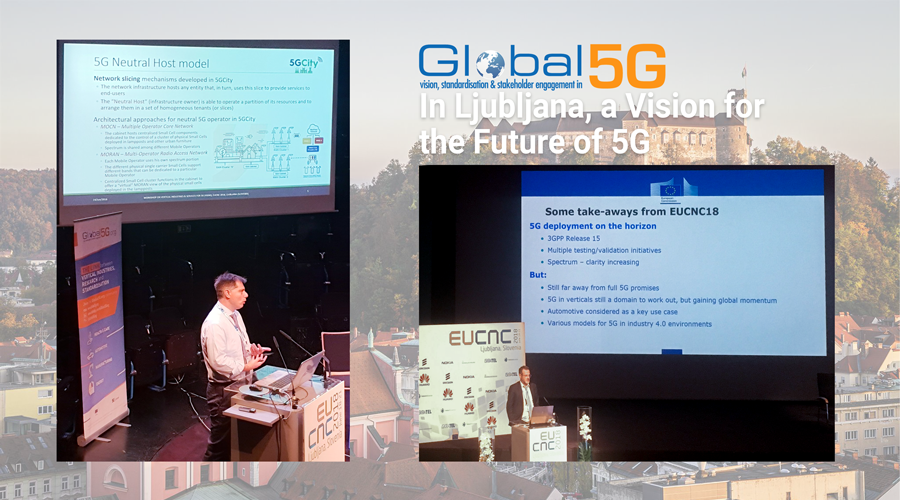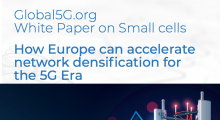International Workshop on Vertical Industries & Services for 5G (VIS5G): In Ljubljana, a Vision for the Future of 5G

As exciting as the technology advances of 5G are, its real future lies in successful and widespread take-up by the vast array of vertical sectors that stand to benefit from its features. But this take-up won’t happen automatically – a rich and constant dialogue both at the technical and application levels must arise between the technology providers and the vertical industry stakeholders. That was the vision of the VIS5G Workshop: to nurture this dialogue into self-sustaining momentum.
The carefully selected “Second Wave” of 5G PPP R&I projects represent the diversity of vertical sectors targeted in Europe for maximum 5G uptake. Here’s a quick overview of key projects and their respective sectors:
- 5G EVE: the aspiration of 5G-EVE is to create the foundations for a pervasive roll-out of end-to-end 5G networks in Europe. 5G-EVE supports this fundamental transition by offering to vertical industries and to all 5G PPP Phase 3 projects facilities to validate their network KPIs and their services. https://5G PPP.eu/5g-eve/
- 5G-VINNI: 5G-VINNI will accelerate the uptake of 5G in Europe by providing an end-to-end (E2E) facility that validates the performance of new 5G technologies by operating trials of advanced vertical sector services. https://5G PPP.eu/5g-vinni/
- 5GENESIS: The “Genesis of 5G” has entered the crucial phase of experimentation, working to validate the 5G network KPIs and verify the 5G technologies with an end-to-end approach. Towards this objective, a key challenge is to integrate all the highly diverse results and technologies from EU, global as well as internal (corporate) R&D projects, to “glue together” the 5G picture and unveil the potential of a truly full-stack, end-to-end 5G platform. https://5G PPP.eu/5genesis/
- 5GCAR: the automobile of the future will be connected, and 5G will unleash the full potential of this connectivity. The aim of 5GCAR is to identify and develop the relevant use cases of connected vehicles of all types (so-called “V2X”) and demonstrate some of the most salient, including lane merge, cooperative maneuvering, and protection of vulnerable road users. https://5g-ppp.eu/5gcar/.
- 5GCity: with its quantum leap in capacity, together with high bandwidths, 5G is the ideal enabler of whole new ecosystems in the city, including municipalities, telecom providers, and infrastructure providers. 5GCity will demonstrate this enabling capability through selected use cases in neutral hosting, media (e.g. Public Service Media), and waste dumping protection. http://www.5gcity.eu/
- 5G-MEDIA: the high capacity/bandwidth offered by 5G is a natural for new media applications, but there is plenty still to do to enable the realization of the myriad new possible offerings, such as the deployment of flexible management and orchestration services. http://www.5gmedia.eu/
- 5G-XCast: an excellent example of a key transversal requirement for a broad array of 5G wireless vertical sectors is the ability to “X-cast” – that is, not only “single-cast” of content but also multiple casting and full broadcast capability. For example, Public Warning Systems depend on this capability for their effectiveness. 5G-XCast will produce innovative, holistic implementations suitable for diverse vertical applications. http://5g-xcast.eu/
- IoRL: The Internet of Radio Light provides the wireless analogue to fiber optics – the use of light waves instead of radio waves – with all of the attendant advantages, including imperviousness to interference, excellent security characteristics (light waves don’t pass through solid walls), and much else. This exciting new 5G technology will enable a host of new vertical services, especially in indoor environments. https://iorl.5g-ppp.eu/
- NRG-5: more efficient energy distribution and utilization is one of the tantalizing promises of 5G technologies. NRG-5 will lay the foundations for Smart Energy as a Service, building on technological advances in the virtualization, decentralization, and multi-ownership of energy assets such as electricity and gas. http://www.nrg5.eu/
- SaT5G: satellite communications have been with us for decades, bringing high capacity and bandwidth (and high latency!) with them. But they have their place in 5G, too, helping to bring coverage to underserved areas, providing backhaul capacity, and helping out with multimedia delivery. SaT5G will deliver innovative new satellite / 5G network integration solutions. http://sat5g-project.eu/
A Highly Interactive, Incisive Verticals Workshop
The VIS5G Workshop kicked off with a keynote by Darko Ratkaj from the European Broadcasting Union (EBU), who shared his insights on how 5G will enable public service media content, but also highlighted the responsibilities that 5G will have in supporting public service media providers in fulfilling their remit – for example, through adequate network coverage, security, reliability, and resilience. He was followed by a second keynote from Erik Ström of Chalmers and the IRACON project (Inclusive Radio Communication Networks for 5G and Beyond). Erik described the challenges of extending 5G technologies in order to maximize 5G inclusivity – that is, to support connectivity at any rates, with any devices, and in any scenarios, such as indoor environments that produce anomalous fading phenomena. He mentioned new approaches such as “model hybridization” which help to deal with the uncertainties introduced by non-deterministic effects.
A series of project presentation sessions introduced the participants to the diversity of 5G-PPP vertical sectors, starting with John Cosmas of Brunel University in a presentation on the Internet of Radio Light and its prospects for dramatic improvement of services in indoor environments. Nicola Ciulli of Nextworks reported on 5GCity, a project for mastering the combination of heterogeneous sensing and data acquisition networks, pools of computing and storage resources, and various fixed/mobile network technologies that will make up a 5G Smart City. He placed special emphasis on the potential role of “neutral hosting” in pulling it all together. Pasquale Andriani of Engineering then described the ambitions of the 5G-MEDIA project to implement use cases involving tele-immersive media, smart & remote media production, and content distribution, while emphasizing the importance of hiding the complexity of the 5G “plumbing” from the developers. A presentation prepared by Georgia Poziopoulou of Avanti Communications introduced the audience to the promise of utilizing satellite technologies to help achieve adequate 5G coverage in wide geographic areas – while noting the challenges of the characteristic latencies. Michael Boniface of IT Innovation gave insights into media service delivery, including considerations of personalization, localization, interactivity, and mobility. An exciting set of 25 different trials will be conducted with the likes of the Disney Corporation, utilizing the FLAME software based 5G platform.
The project presentation sessions segued into a vigorous and lively panel on the topic of Future Trends in Media Distribution. The panelists highlighted a number of issues, such as the need to decouple the content delivery techniques (such as broadcasting) from the user expectation or experience. 5G software-based platforms enable broadcasters to mix match different delivery option, including the ‘long tail’ of user generated content, as in the classic soccer mums example, where a local football match is recorded for distribution to a small set of users. The discussants also highlighted the need for a new approach to the relationship between Mobile Network Operators and public agencies such as the EBU, moving away from a situation of wariness of regulation to one of trust and collaboration.
After lunch, two more keynotes launched the afternoon session. First, Mikael Fallgren of Ericsson presented the activities of the 5G V2X Deployment working group, describing their emphasis on use cases and business aspects, along with spectrum usage, infrastructure capabilities, security, and safety. Given the articulated automotive supply chain, Mikael noted the importance of getting all stakeholders in the supply chain onboard. He was followed by Mingzoo Wu and Shih I Chen on aspects of the Factory of the Future, such as a need for reconfigurability, flexibility, safety, reliability, and much more.
That set the stage for the next project presentation on manufacturing in Clear5G, made by Haibin Zhang of TNO, who explained that within factories there will be private (physically or virtually) factory wide 5G networks tailored to particular needs of individual sites. David Gomez-Barquero of UPV followed with a presentation of the 5G-Xcast project, outlining the complexities of delivering public warning use cases, including the capability to localize warnings, reach devices in sleep mode, capability to reach all people including those with disabilities (hearing, vision etc.). Representing NRG-5, John Davies of BT and Miha Smolnikar of JSI then presented the key issues around 5G for Smart Energy, including increased digitization and prosumerisation due to distribution energy generation, renewable energy sources etc. They also highlighted the need for stability, resilience and high availability, as well as a need to enable fault localization, isolation/self-healing, energy re-routing, etc. The project presentation session was wrapped up with a presentation by Mikael Fallgren of Ericsson on more aspects of the 5GCAR project.
The workshop concluded with a wide-ranging discussion of the Impact of 5G on Verticals. The panelists were in general agreement that there is still too much focus on traditional business models, whereas 5G will raise new questions about exactly who should and will pay in the end. The advent of the GDPR will have a profound impact on security and legal aspects across all verticals. Looking toward the future, the discussions noted a need to approach new verticals not yet represented, such as water supply, as well as a need for those so-called “killer applications” that definitively demonstrate the full power and promise of 5G over the gamut of vertical industries.
Key Takeaways from the Verticals Workshop
- An important target sector for 5G media isn’t just the commercial market, but the public service market, which has differentiating characteristics including different business models (e.g. public value of their services)
- Radio-Light hybrid architectures have the potential to open up dramatically new applications in 5G Home Entertainment Networks, with their high data rates and precise localization accuracy.
- Neutral hosting could provide the key to the takeoff of the Smart Cities concept, allowing cities to do the heavy lifting of providing the 5G infrastructure for service providers while remaining out of the competitive fray. Mobile Network Operators must be convinced that they will not be over-regulated by such developments, but rather will benefit.
- 5G can be technically complex and daunting, and for verticals to succeed, they must provide a friendly environment for applications development in their sectors. A good example is the Media sector, which is currently creating a 5G MEDIA SDK based on the Open Source Management and Orchestration Stack.
- Vertical sectors must carefully monitor the mix of industrials involved in their pilot projects, or the projects will not have the desired impact. For example, in the 5G Automotive WG an urgent need was identified to include more OEMs and road infrastructure operators in order to ensure critical mass of influence in the projects.
- Manufacturing verticals will need to make the benefits of 5G introduction more tangible to their stakeholders in order to achieve the expected penetration. This includes the unifying possibilities of 5G, replacing legacy fragmented solutions.
- One of the most potent arguments for 5G is the potential for improved Public Warning Systems. In order to achieve this, however, it will be necessary to ensure the availability of broadcast capabilities (for obvious reasons).
- While the advent of 5G will surely influence vertical sectors, those same vertical sectors should not underestimate their power to influence the evolution of 5G itself. Crisp, well-targeted requirements from the verticals will create a virtuous cycle of acceleration in the spread of 5G.



